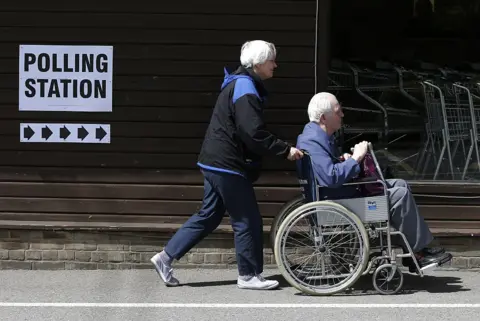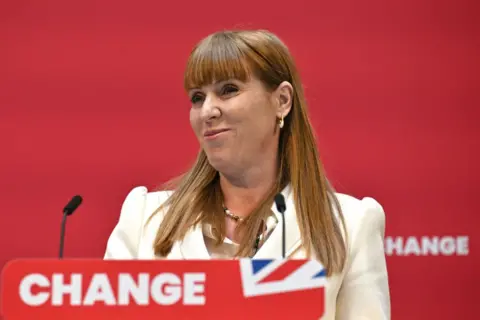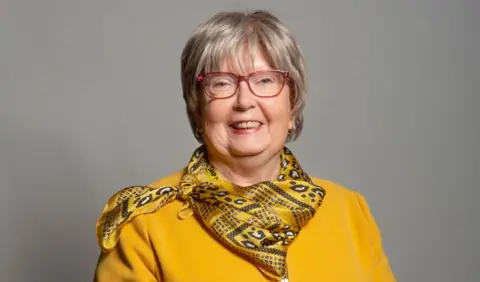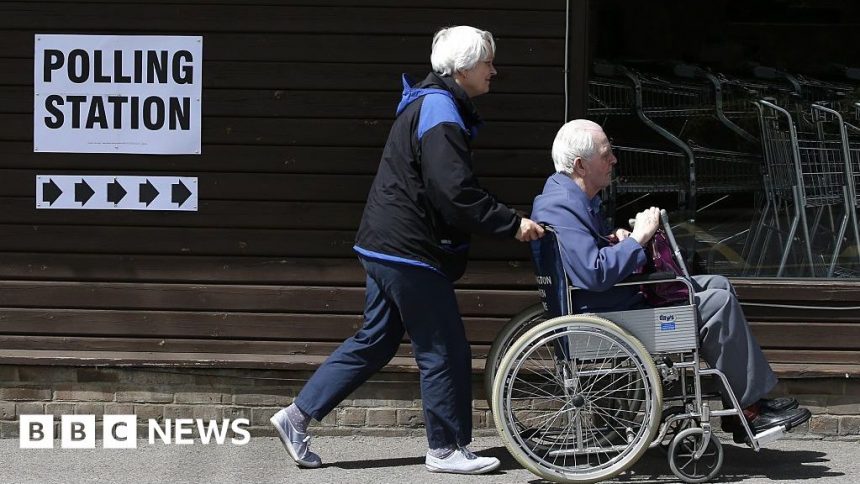What the main parties are saying about disability
 Getty Images
Getty ImagesThere are 16 million disabled people in the UK – almost a quarter of the population – but many say they have felt “invisible” during this election campaign.
The BBC podcast, Access All, asked the main parties about their policies on disability, social care and mental health, and Radio 4’s More or Less examined what they said.
Conservatives
 Getty images
Getty imagesThe Conservatives want to “reform disability benefits” and tighten up what it calls a “sick-note culture”, saying people are now three times more likely to be assessed as not fit for work than a decade ago.
The party’s manifesto says it would create 60,000 new school places and 15 new specialist schools for children with special educational needs (SEND).
It says “mental health should have parity of esteem with physical health” and, as such, it plans to increase the number of clinical placements for those experiencing severe mental illness by 140,000 places.
The Conservatives want to cut £12bn from the UK’s £69bn welfare bill. Disability benefits alone are expected to rise from £39bn to £58bn in 2028/29.
Around £14bn of that is due to increasing Personal Independence Payment (PIP) costs, paid to people with long-term physical or mental health conditions who need support with everyday tasks.
The manifesto gives little detail on the changes beyond pledging a “more objective” assessment and restrictions on claims from people with mental health problems.
There is currently a 12-week consultation on changes to PIP which proposes using medical diagnosis over assessments and replacing PIP cash payments with vouchers and catalogues.
Launched on 29 April, it will be concluded come what may on 4 July, although any changes would require a law to be passed under the next government.
Mims Davies, Minister for Disabled People, Health and Work, says: “I think it’s very reasonable post-Covid, when you see a two-thirds increase, in spending to look at what’s happened. We have a responsibility to make sure that taxpayers’ money is well spent.”
More or Less: Ms Davies says there has been a two-thirds increase in spending since the pandemic. However, if we look at incapacity and disability benefits together with carer’s allowance and housing support in real terms in 2019/20, and we compare that to current spending on the same things in 2024/25, the rise is actually around 40%, not more than 60%.
Labour
 Getty images
Getty imagesLabour wants to improve access to mental health care with specialist professionals in every school and a recruitment drive for an additional 8,500 NHS mental health staff. It also wants special educational needs (SEN) expertise in mainstream schools.
The party wants to get disabled people into work by reforming the Work Capability Assessment, although it has not given details, and by introducing mandatory disability pay gap reporting.
Deputy leader, Angela Rayner says: “Small changes in the workplace can really mean that you have great assets in the people that work for you who can bring around those profits.
“By making sure that employers have to report their disability pay gap, that should reduce, as we have seen in the gender pay gap.”
According to the Office for National Statistics (ONS), the pay gap between disabled and non-disabled employees is 13.8%.
There are strong phrases in the manifesto like “there will be consequences for those who do not fulfil their obligations”.
Ms Rayner says the emphasis is on those who “can work” and “helping people to reach their full potential”.
More or Less: Mandatory gender pay gap reporting was introduced in 2017 for employers with 250 or more employees. They have to submit the average difference in hourly pay between men and women. Since then, the gap has fallen from 9.1% in 2017 to 7.7% in 2023.
Although this might look like a success, closer inspection of ONS figures shows the gap had already fallen significantly before this regulation was introduced. This has led some to question how significant the policy was.
Watch and Listen

BBC Access All is a podcast all about disability and mental health.
You can hear all the interviews here on BBC Sounds.
And watch the BSL editions on BBC iPlayer
Liberal Democrats
 Getty Images
Getty ImagesSocial care is at the heart of leader Sir Ed Davey’s plans. The Liberal Democrats want to reform PIP to stop “unnecessary reassessments” and give disabled people the right to work from home.
It wants to have a mental health professional in every school, bring an end to “out-of-area” mental health placements so people can be treated near home, and introduce one-hour targets for police to hand over someone experiencing a mental health crisis to the relevant service.
Many disabled people have care packages but report a lack of carers to employ. According to the King’s Fund think tank, in 2022/23 there were 152,000 vacancies, or 9.9% of available roles.
As well as providing free personal care (Scotland already has this), the Lib Dems want to introduce a minimum wage for carers, £2 an hour above the national minimum wage, and establish a Royal College of Care Workers.
Sir Ed says this will total about £3.7bn annually. He plans to pay for it by promising to reverse tax cuts the Conservatives have given to the big banks since 2016.
More or Less: Sir Ed’s plan includes spending an extra £2.7bn a year on free personal care by 2028/29. That sounds like a lot but the Health Foundation, the independent charity, estimates it would cost more than twice as much.
The party says it would take into account other money in the system, referring to the Conservatives’ delayed plan to introduce a lifetime cap on personal care of £86,000, due to be introduced next year.
That hasn’t stopped the Lib Dems using it as a building block for their proposed upgrade, and have suggested it will provide £3.6bn a year towards their plans.
The Conservatives are still committed to this cap, but the Institute for Fiscal Studies says the funding set aside for this has already been absorbed into the current care system.
Scottish National Party

The SNP manifesto contains one sentence on disabled people: “Scrap proposed punitive welfare reforms for sick and disabled.”
This most likely relates to the Conservative plan to tighten up the criteria for Work Capability Assessment, which looks at how capable people are of working. The Tories want to reduce those being assessed by 424,000 by 2028/29.
Some benefits including both child and adult disability payments are devolved to Scotland.
“We look at benefits as something people are entitled to,” Marion Fellows, the party’s disabilities spokesperson says.
“We also fund free prescriptions, we’ve introduced a child payment for impoverished families where 100,000 children have been lifted out of poverty.
“The only way to get anything done in the UK parliament, if you are not in power, is to work with other parties and to push the agenda forward.”
More or Less: Ms Fellows mentioned 100,000 children have been lifted out of poverty due to the Scottish Child Payment. This claim comes from a Scottish government report, which predicted the future impact of policies compared with what might have happened without them – the difference between them is the number we’re interested in.
The report acknowledged it relied on a lot of assumptions and, while the report predicts Scottish government policies as a whole will keep 100,000 children out of relative poverty, the Scottish Child Payment related to 60,000 children.
Green Party

The Greens want to put mental health care on a “truly equal footing with physical health” by offering therapies within 28 days and providing trained counsellors in every school and sixth form college.
The party wants to create a “career structure for carers” and offer free personal care with an investment of £20bn per year.
The Green Party’s Mags Lewis says it wants to “restore the value of disabled benefits” with a 5% rise “immediately”. A bill paid for by a windfall tax on some fossil fuels and “taxing the billionaires“.
The Greens also want to provide another 150,000 social houses a year, with “a good proportion” being accessible.
More or Less: The current government has consistently missed its targets to build 300,000 homes annually since 2019.
The Green Party doesn’t promise to build 150,000 social homes a year, just provide them. It proposes local authorities could buy or refurbish older housing stock, which were likely built before accessibility regulations came in.
Plaid Cymru
 Getty Images
Getty ImagesPlaid wants to adopt the UN Convention on the Rights of Disabled People into UK law, which protects the right to live independently and reform the Mental Health Act.
Liz Saville Roberts, the Westminster leader of the party, wants to reduce waiting times for people waiting for neurodiversity assessments, such as autism and ADHD, but says Wales needs more funding.
“We’re always being told that Wales is funded to a greater level per head than England, this is true, but we’re not funded [per head] as highly as, say, London is.”
She wants the patient to be at the centre of their care with greater control and access to their personal information.
More or Less: Government figures show Wales receives £13,967 per head, which is lower than Scotland and Northern Ireland, but 11% above the UK average. London gets £14,486 per person.
Part of London’s high figure is because the capital also receives the highest capital spending in the UK, largely driven by spending on transport, which is used by those who live and visit.
If we excluded that and only looked at current expenditure on services, then Wales has higher funding per resident than London.
Reform UK
 Getty Images
Getty ImagesReform’s manifesto says “the benefit system is broken” and would be changed within 100 days.
Assessments for PIP and Work Capability would be face-to-face and include an independent medical assessment “to prove eligibility for payments”.
Those with severe disabilities or serious long-term illnesses would be exempt from regular re-assessment.
Reform UK declined to take part in Access All’s election interviews. However, on the recent BBC Question Time leaders’ special, Nigel Farage said 9.2 million people of working age are not in employment, adding: “They’re not all layabouts, there are many people, I bet we all know people on benefits who’d love to get back to work.”
More or Less: On the latest figures, economic inactivity has actually increased to 9.4 million – 27% are students, 18% look after the family home, and 30% are long term sick. That’s 2.8 million people. That number has increased significantly since the pandemic, up by 33%, far outstripping growth in the working age population, only 2% over the same time.







